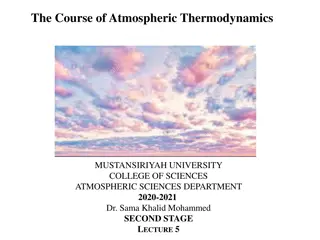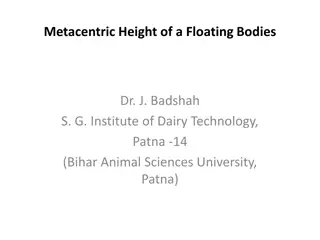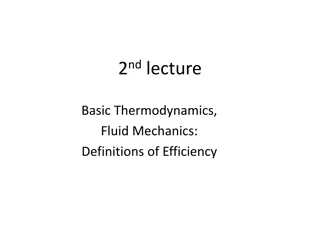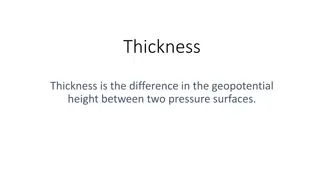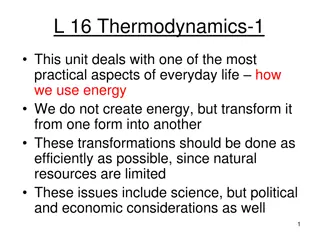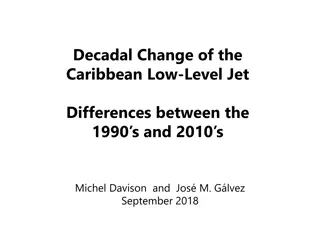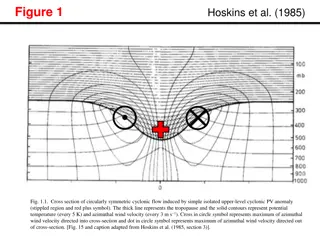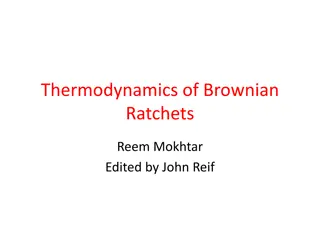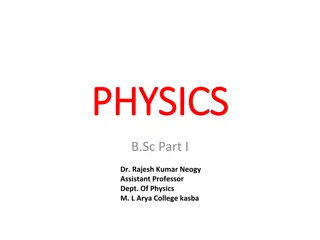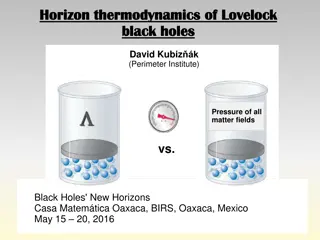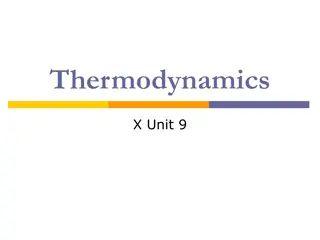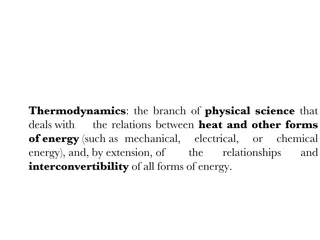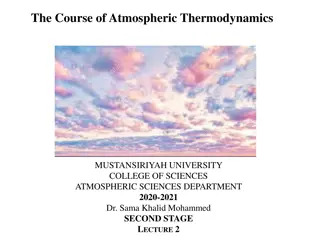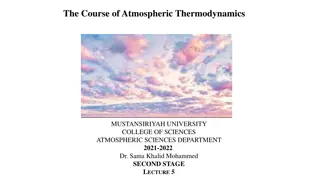Understanding Geopotential and Geopotential Height in Atmospheric Thermodynamics
Explore the concept of geopotential and geopotential height in atmospheric sciences, focusing on their significance in understanding gravitational and centrifugal forces on Earth. Learn about the definition, calculation, and applications of geopotential height in relation to atmospheric properties and geophysical phenomena.
Download Presentation

Please find below an Image/Link to download the presentation.
The content on the website is provided AS IS for your information and personal use only. It may not be sold, licensed, or shared on other websites without obtaining consent from the author. Download presentation by click this link. If you encounter any issues during the download, it is possible that the publisher has removed the file from their server.
E N D
Presentation Transcript
The Course of Atmospheric Thermodynamics MUSTANSIRIYAH UNIVERSITY COLLEGE OF SCIENCES ATMOSPHERIC SCIENCES DEPARTMENT 2020-2021 Dr. Sama Khalid Mohammed SECOND STAGE LECTURE 1
Welcome Students Welcome Students In The In The New Course New Course & In The & In The First Lecture First Lecture
This lecture including the following items Geopotential and Geopotential Height Thickness and the hypsometric equation Exersice
GEOPOTENTIAL (z) Since Earth is rotating, the force observed as Gravity is the resultant of the: Gravitational acceleration + Centrifugal acceleration from the Earth s rotation. The acceleration due to gravity is not constant, it varies from place to place, with the largest variation due to latitude. Though small, the variation in gravity must be accounted via the concept of geopotential.
GEOPOTENTIAL (z) Definition: the potential energy of a unit mass relative to sea level, numerically Work that must be done against the Earth s gravitational field in order to raise a mass of 1 kg from sea level to that point. Units: Work is defined as force * distance. It has units of Joules (J). So the work to lift a mass a certain height is: J kg-1. Since a Joule is also defined as a Newton * meter, where Newton = kg m s-2, we can substitute for J above to yield an alternative unit for geopotential: m2 s-2 The symbol for geopotential is . Geopotential is defined as having a magnitude of 0 at the Earth s surface. The at any height above the Earth s surface is equivalent to the distance traveled multiplied by the gravity at each integration of height: zgdz 0 = .(1) ( ) z
GEOPOTENTIAL (z) zgdz 0 = d gdz ( ) z or where z = height above the surface, and g is the gravity at each height, and be calculated via the following equation A surface of constant geopotential represents a surface along which all objects of the same mass have the same potential energy. If gravity were constant, a geopotential surface would lie at a constant altitude, but it is not constant throughout the atmosphere it decreases as the distance from the center of the earth increases. So a geopotential surface will have varying altitude.
Geopotential Height Z The geopotential height is defined as the geopotential at height Z (Equation 1) divided by the gravitational acceleration at the surface of the Earth (go). It is represented as a capital Z . Z ( ) 1 z z = Z gdz (2) g g 0 o o Where go is the globally averaged acceleration due to gravity at the Earth s surface called standard gravity (~ 9.81m/s2), g is acceleration of gravity. dz
Geopotential Height Z Geopotential height is used as the vertical coordinate in most atmospheric applications in which energy plays an important role (e.g., in large-scale atmospheric motions). It is expressed in geopotential meters, abbreviated as gpm. Note that as geometric altitude (z) increases, Z becomes increasingly less because the gravitational acceleration is decreasing. This means less work is required ( (z) is getting smaller) to lift the mass to that point because the opposing force (g) is decreasing. ( ) 1 z z = Z gdz (2) g g 0 o o
Geopotential Height Z In the lower atmosphere, Z is very close to z (called the geometric or actual height ) where go ~ g, The table below shows how Z,z, and g vary with height at a typical mid-latitude location. g(ms-2) 9.802 9.798 9.771 9.741 9.71 9.62 9.531 9.443 9.327 9.214 8.94 8.677 8.427 8.186 z(km) 0 1 10 20 30 60 90 120 160 200 300 400 500 600 Z(km) 0 1 9.986 19.941 29.864 59.449 88.758 117.795 156.096 193.928 286.52 376.37 463.597 548.314
Geopotential Height Z If the change in gravity with height is ignored, geopotential height and geometric height are related via If the local gravity is stronger than standard gravity, then Z > z. If the local gravity is weaker than standard gravity, then Z < z. Gravity varies, at the North Pole is approximately 9.83 m/s2, while at the Equator it is about 9.78 m/s2. Therefore, g/g0 ~ 1, and for many applications we can ignore the difference between geopotential and geometric height, since Z ~ z. But, keep in mind that they are different, and at times this difference, though small, is very important and cannot be neglected.
Geopotential Height Z So why care about Z and ? 1. It can be used to derive the hypsometric equation. 2. Effective gravity (g) is perpendicular to lines of constant geopotential surfaces, not geometric height 3. It is frequently used to convert surface pressures to mean sea level pressures, through manipulation of the hypsometric equation.
Thickness and the hypsometric equation The hypsometric equation tells us that the thickness between two pressure levels is directly proportional to the average temperature within the layer. We can use thickness as a measure of the average temperature of a layer. We can use contours of thickness in a similar manner to how we use isotherms. Colder layers are thinner, warmer layers are thicker.
Why using hypsometric equation Weather observing stations measure station pressure, which must be converted to sea-level pressure for reporting and plotting on weather charts. The method of calculating the sea-level pressure is called pressure reduction or reducing the pressure to sea-level Sea-level pressure reduction is accomplished via the hypsometric equation, treating Z1 = 0 as sea level, and Z2 = Zsta as the geopotential height of the station. This means p1 = psl, the sea-level pressure, P2 = Psta, the station pressure, and by Rearranging hypsometric equation with these definitions give: There are different formulas used in various applications according to the layer-average temperature in the hypothetical atmospheric layer between the surface and sea level.
Exercise 1. If the thickness of the 1000 500 hPa layer is 5400 gpm, what is the layer average temperature in kelvin? 2. What is the geopotential and why it is used? 3. How to reduce the pressure at the station to the pressure at MSL? Write down a formula.


